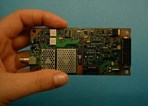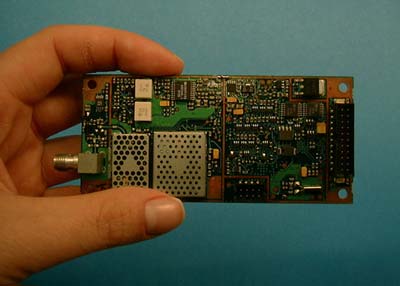Telemetry — The evolution of a technology

By Stephen Larghi, technical vice president of Wireless Control Systems, Weblink Wireless
Telemetry has grown in the last 150 years from a technology with a narrow range of uses into a mature, commercially viable technology with a virtually limitless range of applications. In fact, a 1999 study by The Yankee Group suggests that the market for wireless telemetry will swell to more than $6.6 billion in revenues by the year 2004. The report argues that as the price for telemetry units and services drop over time, the universe of machines using telemetry will increase dramatically.

Telemetry module
The study explains that the explosive growth will be fueled by the convergence of three technologies: wireless, computing, and the Internet, leading to the development of numerous affordable, practical tools and components that will fit into a seamless end-to-end system.
Although telemetry was originally employed mainly by the aerospace industry, through the combination of computers and powerful wireless networks, it has become a technology that will touch everyone on a daily basis.
Present and future applications
Telemetry technology has progressed to the point where applications are limited only by the imagination. There are myriad scenarios where telemetry can improve efficiency and increase revenues. Wireless narrowband personal communications services networks, better known as narrowband PCS (N-PCS), are making those scenarios a reality sooner than anyone could have conceived just a few years ago.
There are several markets where telemetry is employed. Companies in the heating, ventilation, and air conditioning industry (HVAC) are using wireless telemetry to perform routine maintenance checks on HVAC equipment, eliminating the need for maintenance visits by technicians. Companies in the security business use telemetry to transmit primary and back-up alarm status and information about systems operation.
Office equipment manufacturers are turning to telemetry to track fax, copier, and printer usage. Instead of relying on the outdated, inaccurate manual reporting process wherein company employees phone in a meter count, the copy count is sent in wirelessly using N-PCS telemetry. In another innovative implementation of the technology, an automotive anti-theft and tracking device company takes advantage of telemetry to monitor vehicle location remotely in lieu of more expensive means of data transmission.
These applications only scratch the surface of the potential that telemetry offers. Another example is stolen car reporting/disabling. Using telemetry, the owner could remotely disable the car's fuel pump, bringing the car to a gradual stop. Medical equipment makers could employ telemetry to upload information about a patient's condition. Electronic signs can be fitted with wireless devices and turned off from a central monitoring station, eliminating the need to run phone lines from the sign to the station. Telemetry can also be used to keep track of vending machine stock, saving drivers unnecessary trips to replenish supplies in machines.
N-PCS role in telemetry
Narrowband PCS uses Motorola's ReFLEX 25 two-way advanced messaging protocol to transmit the data in two-way telemetry applications. The protocol defines the manner in which message and control data are sent to the telemetry device and messaging receiver. The protocol also provides a choice of multiple inbound and outbound signaling speeds for messages sent from a messaging unit, allowing the system to operate with the fewest number of receiver sites for a given level of traffic.
N-PCS is ideal for telemetry applications because its low bandwidth needs makes its cost competitive with other technologies. As businesses become telemetry savvy, it is expected they will begin to take advantage of telemetry that uses the technology more extensively.
Nuts and bolts
Unlike current one-way data networks that employ only an outbound channel, N-PCS networks consist of both an outbound channel and an inbound channel, each operating on separate frequencies. The outbound channel is used by the network transmitters to send messages to the telemetry device. The inbound channel is used by the device to send information to the network receivers. These two, independent frequencies are the key elements that allow two-way flow of data and messages to take place.
In 1994, the FCC auctioned narrowband PCS frequencies, primarily in the 940 MHz range. The ability of a wireless company to compete in the future was quickly determined by its ability to purchase nationwide licenses. When the concept of two-way data communications was becoming a reality, Motorola assisted Mtel, now known as SkyTel, in developing the ReFLEX 50 data transmission protocol. Early adopters were quick to join in the excitement created around the introduction of a two-way network in 1996.
WebLink Wireless has developed its two-way network-using ReFLEX 25, which Motorola developed as an architecture it could provide to the entire wireless messaging industry. It is a second-generation protocol that benefited from the installation and operations problems found during infancy of ReFLEX 50.
Features
- Oriented to work with the Internet
- Efficient inbound channels: a density of 1:1 ratio of receivers to transmitters
- Fewer garbled messages
- Improved in-building penetration
- Uses sub-zoning, enabling high-density markets to be sub-divided
- Volume drives price—more ReFLEX 25 carriers mean more software developers and equipment manufacturers, which lowers costs
Although much of the initial development in telemetry has centered around automatic meter reading and telematics, The Yankee Group report says that the broad applicability of wireless telemetry has resulted in a beehive of activity going beyond these industry segments.
For example, the report notes that although service providers have been providing wireless airtime, opportunities have also arisen for utility companies, automobile manufacturers, and even enterprise computer management companies. The report goes on to say that there is a large market for wireless telemetry transceivers, which in turn creates a latent demand for wireless airtime. The two fundamental drivers behind this widespread adoption of telemetry will be cost savings and process efficiencies.
About the author
Stephen Larghi is technical vice president of Wireless Control Systems for WebLink Wireless. He can be reached at WebLink Wireless, 3333 Lee Parkway, Dallas , TX 75219; phone: 214-765-3654, stephen.larghi@weblinkwireless.com. (Back to top)
